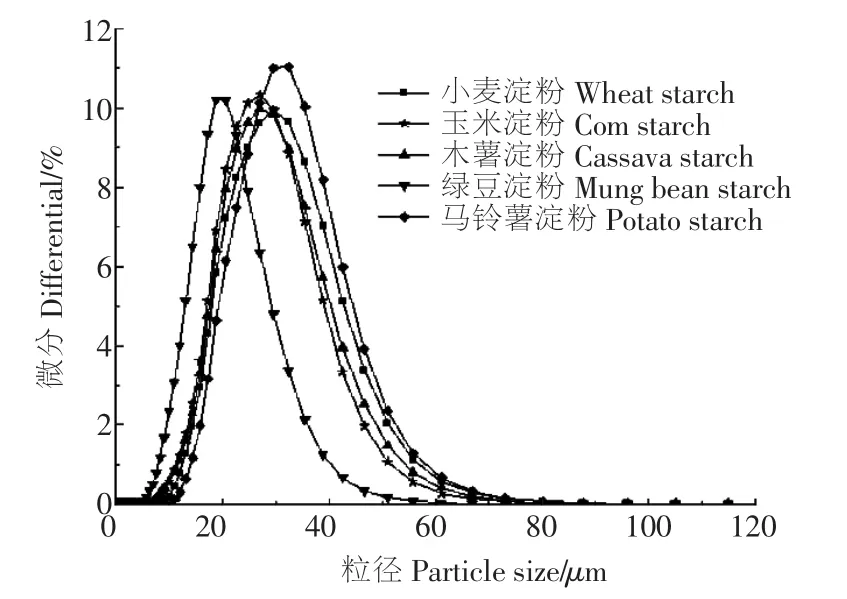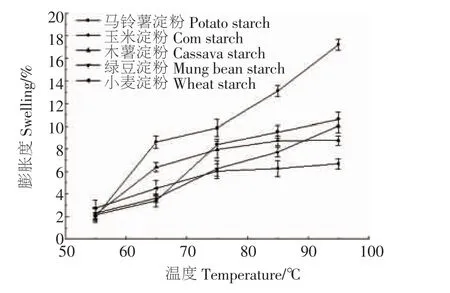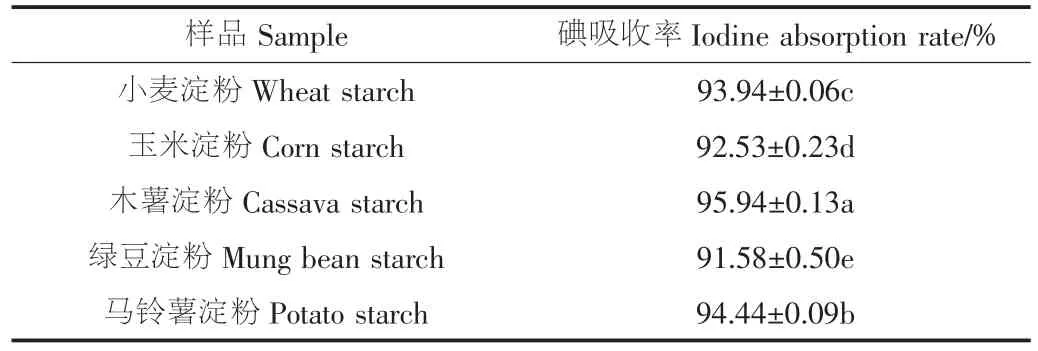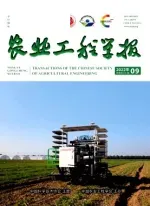不同来源淀粉特性对水晶皮质构品质的影响
2016-04-09艾志录孙茜茜潘治利谢新华田萍萍河南农业大学食品科学技术学院郑州450002速冻面米及调制食品河南省工程实验室河南省高校重点实验室培育基地郑州450002河南粮食作物协同创新中心郑州450002
艾志录,孙茜茜,潘治利,2,谢新华,索 标,田萍萍(.河南农业大学食品科学技术学院,郑州450002;2.速冻面米及调制食品河南省工程实验室,河南省高校重点实验室培育基地,郑州450002;3.河南粮食作物协同创新中心,郑州450002)
不同来源淀粉特性对水晶皮质构品质的影响
艾志录1,3,孙茜茜1,潘治利1,2,谢新华1,索标1,田萍萍1
(1.河南农业大学食品科学技术学院,郑州450002;2.速冻面米及调制食品河南省工程实验室,河南省高校重点实验室培育基地,郑州450002;3.河南粮食作物协同创新中心,郑州450002)
摘要:为了研究原料淀粉特性对水晶皮质构品质的影响,该文选用小麦、玉米、马铃薯、木薯、绿豆5种淀粉原料,测定并分析淀粉颗粒特性、破损淀粉含量、糊化特性与水晶皮的透明性、质构等品质的关系。结果表明:不同来源的淀粉制作水晶皮品质差异较大,小麦淀粉皮品质最好,其次是马铃薯、木薯、玉米淀粉皮,绿豆淀粉皮品质最差。淀粉颗粒特性、破损淀粉含量与水晶皮品质指标密切相关。平均粒径、膨胀度越大,水晶皮亮度、透明性越好;适宜的破损淀粉含量能够保证水晶皮较好的综合质构品质;淀粉的糊化特性与水晶皮品质指标之间存在显著相关性;淀粉峰值粘度和衰减值与水晶皮透光率呈极显著正相关。谷值粘度、最终粘度、回生值与水晶皮硬度、弹性、咀嚼性、剪切力呈极显著正相关,起始糊化温度与水晶皮品特性相关性不显著。因此,在水晶皮制作进行原料选择时,可以测定淀粉粒径、膨胀度、峰值粘度、衰减值来预测淀粉皮亮度与透光率;测定淀粉破损淀粉含量、谷值粘度、最终粘度、回生值来预测淀粉皮适口性等品质特性。该文旨在为加工水晶产品原料选择以及品质改善提供基本的理论支撑。
关键词:淀粉;品质控制;农产品;颗粒特性;水晶皮;糊化;质构品质
艾志录,孙茜茜,潘治利,谢新华,索标,田萍萍.不同来源淀粉特性对水晶皮质构品质的影响[J].农业工程学报,2016,32(01):318-324.doi:10.11975/j.issn.1002-6819.2016.01.044 http://www.tcsae.org
Ai Zhilu, Sun Xixi,Pan Zhili, Xie Xinhua, Suo Biao, Tian Pingping.Effect of different starch source properties on crystal leather textural quality[J].Transactions of the Chinese Society of Agricultural Engineering(Transactions of the CSAE), 2016, 32(01): 318-324.(in Chinese with English abstract)doi:10.11975/j.issn.1002-6819.2016.01.044 http://www.tcsae.org
0 引言
自古以来,在人们的主食结构中,面制品都扮演着非常重要的角色。如今,随着面制品市场产品的日益丰富,人们对产品的要求,除了要好吃、营养丰富以外还要求要美观并有较强的可接受性。水晶类淀粉制品如:水晶虾饺、水晶月饼等,以其剔透的外观、光滑的表面、细腻而有韧性的口感深受消费者的喜爱,因此提高这类产品的透明度等品质就尤为重要。淀粉类产品的性质及品质的优劣,不仅与加工过程中相关,更与淀粉的品种及其糊化性质密切相关[1-5]。近些年来许多学者对淀粉糊透明性影响因素进行探究,认为淀粉的颗粒大小、膨胀能力、介质环境、常用添加剂、改性淀粉都显著影响淀粉糊的透明性[6-10]。杜先锋等[7]研究了淀粉糊的透明度以及氯化钠、蔗糖、柠檬酸等食品成分和老化作用对透明度的影响。认为分子结构是影响淀粉糊透明度高低的内在因素,对于所添加的食品成分来说氯化钠降低淀粉糊的透明度,而蔗糖、柠檬酸则提高糊液的透明度。黎晓等[6]认为,与原淀粉相比,木薯淀粉磷酸酯透明度和表观黏度明显提高。且随取代度的增大而增高,不同介质对其透明度和表观黏度影响不同,其中氯化钠对其影响较大。然而这些研究都只是对于淀粉糊的研究,而对于真正的淀粉类产品的透明度,以及破损淀粉对于淀粉产品透明度的影响国内外却鲜有研究。
本文选择小麦、玉米、马铃薯、木薯、绿豆等常用淀粉原料,测定并分析淀粉特性、破损淀粉含量对水晶皮的透明性等品质的影响,旨在为加工水晶产品原料选择以及品质改善提供基本的理论支撑。
1 材料与方法
1.1试验材料
小麦淀粉(含水率12.27%,蛋白质质量分数0.40%),范县黄河实业有限公司;玉米淀粉(含水率12.62%,蛋白质质量分数0.37%)、马铃薯淀粉(含水率20.63%,蛋白质质量分数0.18%)、木薯淀粉(含水率11.55%,蛋白质质量分数0.17%)、绿豆淀粉(含水率16.6%,蛋白质质量分数0.27%),无锡市天之源食品有限公司;猪油,沂城金锣肉制品集团有限公司;试验所用的无水乙醇、硼酸、碘化钾、硫代硫酸钠均为分析纯。
1.2主要仪器与设备
Rise-2008型激光粒度分析仪,济南润之科技有限公司;T6新世纪紫外可见分光光度计,北京普析通用仪器有限公司;RVA4500粘度分析仪,瑞典波通仪器公司;TDL-5-A低速大容量离心机,上海安亭科学仪器厂;RQH-250型程控人工气候箱,上海新诺仪器设备有限公司;SD mat ic型破损淀粉测定仪,法国肖邦公司;A-XT2i物性分析仪,英国Stable Micro System;Sortourius电子天平,北京赛多利斯天平有限公司;SHZ-82A水浴恒温震荡器,金坛市医疗仪器厂;DHG-9143BS-Ⅲ-电热恒温鼓风干燥箱,上海新苗医疗器械制造有限公司;Minolta Color Miniscan CR400色差仪,日本美能达公司。
1.3试验方法
1.3.1淀粉特性的测定
1)淀粉粒径测定
采用Rise-2008型激光粒度分析仪测定,测定条件:遮光比1%~2%;分散剂:乙醇;分散剂折光率:1.33%,测定量程:0.02~1 200 μm。
2)淀粉膨胀性质的测定[11]
将不同品种的淀粉分别配制成质量分数为2%的淀粉乳,在不同温度的水浴中加热搅拌30 min,在3 000 r/min条件下离心30 min,取上清液在水浴上蒸干,并在105℃烘至恒重,称重得被溶解淀粉质量A,按公式(1)计算淀粉的溶解度S;由离心管中膨胀淀粉质量P,即离心后离心管中沉淀淀粉质量,按公式(2)计算淀粉的膨胀度B:

式中:W为淀粉质量,g,以干基计。
3)淀粉中破损淀粉含量的测定
使用肖邦SD matic型破损淀粉测定仪进行测定,在反应杯中加入120 mL蒸馏水、3 g硼酸和3 g碘化钾,将反应杯放入卡槽内时加入1滴硫代硫酸钠(0.1 mol/L),再称取1 g淀粉样品,放到仪器样品小斗中,点击开始,测定破损淀粉值,用碘吸收率(%)来表示破损淀粉含量。
4)淀粉糊化特性的测定[12]
采用RVA-Super4粘度分析仪对淀粉糊化特性进行测定,测定时先在RVA专用样品筒中加入(25±0.1)mL蒸馏水(按14%湿基换算),然后称取(3.0±0.01)g淀粉(按14%湿基校正),移入已加有蒸馏水的样品筒中。最初10 s转子以960 r/min搅拌,待样品筒中形成均匀悬浊液后,保持160r/min转速直至试验结束。采用美国谷物化学家协会(American Association of Cereal Chemists,AACC)标准温度模式即RVA初始温度为50℃保持1 min,然后升高至95℃,在95℃保持2.5 min后,再降至50℃并保持2 min。测量结果单位用快速粘度分析仪单位(cp)表示,每个样品重复3次,结果取平均值。
主要试验参数:峰值粘度(peak viscosity)、谷值粘度(trough viscosity)、粘度破损值(breakdown)、最终粘度(final viscosity)、回生值(setback)、起始糊化温度(pasting temperature)。
1.3.2水晶皮的制作
称取淀粉100g,加水量为淀粉质量的80%,水温100℃,猪油添加量为淀粉质量的3%,和至成团,用纱布覆盖,在25℃条件下,静置熟化20 min。将熟化后的淀粉团制成质量约3 g的小剂子,用模具制成直径约5 cm,厚约2 mm的淀粉皮,大火蒸制5 min备用。
1.3.3水晶皮品质指标的测定
1)水晶皮透明性的测定
参照李光磊[13]的方法略加改进,将蒸熟的淀粉皮冷却5 min后,用刀切成宽约5 mm、长约4 cm的长条,放入1 cm的石英比色皿中(每次保证淀粉皮处于比色皿同一侧)在620 nm波长条件下测其透光率。每种样品制成6个长条进行测定,6次结果求平均值。
2)水晶皮亮度的测定
水晶皮亮度采用色彩色差计进行测定。方法如下:采用CIE—L*a*b*色空间表示方法,L代表亮度。将熟制的淀粉皮冷却3 min后进行亮度的测定。每种样品测定6次求平均值。
3)水晶皮质构特性的测定
参照樊奇良和叶晓枫[14-15]的方法,将熟制的淀粉皮冷却5 min后用质构仪测定。每种样品取样6次测定并求平均值,物性分析仪的具体参数设定见表1。

表1 物性分析仪参数设定Table 1 Parameter of texture analyzer
1.3.4数据分析
试验数据采用SPSS13.0进行单因素方差分析和相关性分析,用Origin8.0软件作图。
2 结果与分析
2.1不同来源淀粉的粒径分布
由图1和表2可知,不同来源的淀粉颗粒粒径分布有明显的差异。粒径较大的是马铃薯淀粉,粒径范围为:9~105 μm,平均粒径为30.35 μm。粒径最小的是绿豆淀粉,粒径范围为:4~74 μm,平均粒径为19.27 μm。小麦、玉米、木薯淀粉的粒径较为接近,平均粒径分别为:27.92、25.63和26.35 μm。周爱梅等[11]认为淀粉颗粒的大小由遗传决定,与淀粉的生物合成机理有关,并且直接影响淀粉粒的相关性质。有研究表明,淀粉的许多理化性质,如膨胀能力,与水结合能力,糊化以及凝胶化能力等都与淀粉的平均颗粒尺寸有关[16]。

图1 不同来源淀粉颗粒粒径分布图Fig.1 Particle size distribution of starch from various sources

表2 不同来源淀粉颗粒粒径分布Table 2 Particle size distribution of starch from various sources
2.2不同来源淀粉的膨胀特性
图2和图3是不同来源淀粉溶解度和膨胀度随温度变化情况图。由图可知淀粉的溶解度和膨胀度都是随着温度的升高而增大。除了在85℃时木薯淀粉的溶解度高于马铃薯淀粉,其余温度下马铃薯淀粉的溶解度和膨胀度均是最高的。这可能是因为薯类淀粉有较低的糊化温度,直链淀粉较早溶出,淀粉颗粒表现出了较高的膨胀度。玉米、小麦、绿豆淀粉则有着相对较小且较为接近的溶解度和膨胀度,这与袁美兰等[17]的研究结果一致。

图2 不同来源淀粉的溶解度Fig.2 Solubility of starch from various sources

图3 不同来源淀粉的膨胀度Fig.3 Swelling of starch from various sources
2.3不同来源淀粉的破损淀粉含量
破损淀粉是指在制粉时,由于机械的碾压作用,有少量的淀粉外层细胞膜被损伤,从而造成淀粉粒的损伤。破损淀粉对面制品的蒸煮品质有一定影响,其含量太高或太低均不能制作出优质的产品[18]。由表3可知,5种淀粉的破损淀粉含量数值差异显著(P<0.05)。碘的吸收率大小表现为:木薯淀粉>马铃薯淀粉>小麦淀粉>玉米淀粉>绿豆淀粉,即5种淀粉的破损淀粉含量大小顺序为:木薯淀粉>马铃薯淀粉>小麦淀粉>玉米淀粉>绿豆淀粉。有研究表明破损淀粉吸水率比未破损淀粉高2.5倍,因此破损淀粉含量高的淀粉拥有较高的吸水性,这与本文膨胀度的测定结果一致。

表3 不同来源淀粉的破损淀粉含量Table 3 Damaged starch content of starches from various sources
2.4不同来源淀粉的糊化特性
RVA测定的是从淀粉颗粒吸水和溶胀开始,到颗粒结构在剪切力的作用下被破坏,淀粉分子浸出的过程[19]。不同来源淀粉糊化特性值如表4所示,可以看出5种淀粉的糊化特性值差异性显著(P<0.05)。峰值黏度反映的是淀粉在糊化升温过程中淀粉颗粒的膨胀程度。由表4可知马铃薯淀粉的峰值黏度最大,玉米淀粉的峰值黏度最小。这表明马铃薯淀粉颗粒在糊化过程中有较大膨胀程度,玉米淀粉膨胀程度较小。衰减值反映淀粉热糊的稳定性,由表4可知小麦和玉米淀粉的衰减值较小,这表明淀粉颗粒膨胀过程中强度比较大,不易破裂,热糊的稳定好,而马铃薯淀粉和木薯淀粉的衰减值较大,说明热糊稳定性差。回生值反映淀粉冷糊的稳定性和老化程度[20]。表4结果表明绿豆淀粉的回生值最高,马铃薯淀粉的回生值最低,说明马铃薯淀粉稳定性差,易老化。由表4可知起始糊化温度由高到低的淀粉分别为小麦、玉米、绿豆、木薯、马铃薯淀粉,研究表明这可能与淀粉颗粒的粒径有关,由于小颗粒淀粉之间堆积紧密,造成糊化比较困难,至使淀粉的成糊温度较高[21]。

表4 不同来源的淀粉糊化特征值Table 4 Gelatinization characteristics of starch from various sources
2.5不同来源淀粉皮的质构品质特性
有研究表明,产品的质构特性与其感官品质之间有显著相关性[22-23],因此用质构仪来测定淀粉皮的质构特性可以避免人为感官带来的差异,测定结果更为真实可靠。不同来源的淀粉皮品质特性值如表5所示,从表中可以看出,不同来源的淀粉制皮后品质指标差异显著。亮度和透明度是水晶皮的重要指标,由表5可知在相同的条件下小麦淀粉皮亮度最高,玉米、木薯、马铃薯淀粉制皮亮度差异不显著,绿豆淀粉皮亮度最差,可能是与原料自身略带颜色有关。对于透光率,马铃薯淀粉皮透光率最高,其次是木薯、小麦淀粉皮,且两者差异不显著,绿豆淀粉皮透明性最差。从淀粉皮质构特性分析,绿豆淀粉皮略硬,玉米淀粉皮质地较软烂,而相较于透明度较好的马铃薯与木薯淀粉皮,小麦淀粉皮有较好的咀嚼性,较为适中的硬度、弹性和剪切力,即拥有较好的适口性,且在工艺制作上,由于薯类淀粉粘性较大,不太容易制皮,因此综合分析小麦淀粉更易制作水晶皮,且拥有较为优异的品质特性。

表5 不同来源的淀粉皮质构品质特性值Table 5 Crystal leather textural quality characteristic values from different sources
2.6淀粉特性与水晶皮质构品质特性相关性分析
2.6.1淀粉颗粒特性、破损淀粉含量与水晶皮质构品质特性相关性分析
表6为淀粉颗粒特性、破损淀粉含量与水晶皮质构品质特性相关性分析结果,从表中可以看出淀粉平均粒径与水晶皮亮度、透光率均呈极显著正相关,这与何晋浙、常虹等[24-25]研究结果一致。淀粉平均粒径与水晶皮弹性呈极显著负相关,与咀嚼性呈显著负相关,说明淀粉粒径越大,越易膨胀,淀粉持水性越强,淀粉皮弹性、咀嚼性越差,谭洪卓等[26]在蚕豆淀粉与粉丝品质关系研究结果中也有相同的表述。淀粉颗粒在95℃条件下的膨胀度与水晶皮的透光率显著正相关,与水晶皮其他品质特性没有显著相关性。淀粉中破损淀粉含量与水晶皮亮度显著正相关,与透光率呈极显著正相关,这是因为破损淀粉的存在使得水晶皮在蒸制过程中吸收相对较多的水分,淀粉颗粒易于膨胀,直/支链淀粉能够充分伸展,产品呈现较高亮度和透明度。但是破损淀粉含量与产品的弹性和咀嚼性均成显著负相关,这说明破损淀粉含量高时产品的适口性较差,因此综合考虑水晶皮的质构品质特性,淀粉的破损淀粉含量应控制在一定的范围内,对于本研究中的5种淀粉,小麦淀粉的破损淀粉含量(约为93.94%)较为适宜。

表6 淀粉颗粒特性、破损淀粉含量与水晶皮质构品质特性相关性分析Table 6 Correlations between starch granules characteristic, damaged starch content and crystal leather textural quality characteristic
2.6.2淀粉糊化特性与水晶皮质构品质特性相关性分析
表7为淀粉糊化特性与水晶皮质构品质特性相关性分析结果。对于水晶类制品,透明性是相对较为重要的指标,直接影响消费者对于水晶类制品的感官认知,由表7可以看出淀粉峰值粘度和衰减值与水晶皮透光率呈极显著正相关,说明淀粉的膨胀程度越大,热糊稳定性越好,淀粉皮透明性越好。回生值与最终粘度与透光率有显著负相关性,这是由于回生值在一定程度上反映淀粉的老化趋势,淀粉老化分子重组必然降低水晶皮透明性。因此在水晶类产品制作时,为提高产品的亮度和透明度,原料应有较高的粒度、膨胀度、峰值粘度和衰减值,较低的回生值和最终粘度。
淀粉皮的质构特性反映的是产品的适口性,谷值粘度、最终粘度、回生值与水晶皮硬度、弹性、咀嚼性、剪切力呈极显著正相关,说明提高这些糊化特征值能够使水晶皮有较好的弹韧性和咀嚼性。因此谷值粘度、最终粘度、回生值是表征淀粉皮的质构特性的重要指标,按显著程度的大小排序:最终粘度>回生值>谷值粘度。起始糊化温度与水晶皮品质特性没有显著相关性。因此在水晶皮制作原料选择及品质改良上,原料的糊化特性可以作为重要考核指标。

表7 淀粉糊化特性与水晶皮质构品质特性相关性分析Table 7 Correlations between starch pasting properties and crystal leather textural quality characteristic
3 结论
1)不同来源的淀粉制做水晶皮质构品质差异较大,小麦淀粉皮品质最好,亮度为77.81,透光率为22.83%,有较好的质构特性,其次是马铃薯、木薯、玉米淀粉皮,绿豆淀粉皮品质最差。
2)淀粉颗粒特性、破损淀粉含量与水晶皮品质指标密切相关。平均粒径、膨胀度越大水晶皮亮度、透明性越好。破损淀粉含量应保持在一定范围内,水晶皮才能有相对较好的综合质构品质,本研究中破损淀粉含量用碘吸收率表示为93.94%时,水晶皮品质较好。
3)淀粉的糊化特性与水晶皮质构品质特性之间存在显著相关性。对于透光率而言,淀粉峰值粘度和衰减值与水晶皮透光率呈极显著正相关。谷值粘度、最终粘度、回生值与水晶皮硬度、弹性、咀嚼性、剪切力呈极显著正相关,按显著程度的大小排序:最终粘度>回生值>谷值粘度。起始糊化温度与水晶皮质构品特性相关性不显著。
4)制作虾饺等水晶类制品的外皮要求有较高的透明性,有光泽同时要有适当的韧性、弹性,有较好的适口性。因此评价淀粉品种对于水晶皮制作适应性时,可以测定淀粉粒径、膨胀度、峰值粘度、衰减值来预测淀粉皮亮度与透光率;测定淀粉破损淀粉含量、谷值粘度、最终粘度、回生值来预测淀粉皮适口性等品质。
[参考文献]
[1] Lin J H, Kao W T, Tsai Y C, et al.Effect of granular characteristics on pasting properties of starch blends [J].Carbohydrate Polymers, 2013, 98(2): 1553-1560.
[2]谢新华,艾志录,王娜,等.不同介质对玉米淀粉糊化黏度特性的影响[J].中国粮油学报,2010,25(3):37-39.Xie Xinhua, Ai Zhilu, Wang Na, et al.Effects of different media on paste property of corn starch[J].Journal of the Chinese Cereals and Oils Association, 2010,25(3): 37-39.(in Chinese with English abstract)
[3]窦红霞,杨特武,赵思明,等.不同品种籼米化学成分、凝胶和糊化特性及米粉加工品质比较[J].中国粮油学报,2014,29 (3):1-6.Dou Hongxia, Yang Tewu, Zhao Siming, et al.Comparison on main chemical components, gelatinization, pasting properties and processing adaptability for rice noodle of different indica rice varieties [J].Journal of the Chinese Cereals and Oils Association, 2014,29(3): 1-6.(in Chinese with English abstract)
[4] Sandhu K S, Kaur M, Mukesh.Studies on noodle quality of potato and rice starches and their blends in relation to their physicochemical, pasting and gel textural properties[J].LWTFood Science and Technology, 2010,43(8): 1289-1293.
[5]张豫辉,陆启玉.淀粉及其结构、性质对面条品质影响的研究进展[J].粮食与油脂,2014,(12):20-23.Zhang Yuhui, Lu Qiyu.Study on the effects of structure and properties of starch on noodle quality[J].Cereals and Oils, 2014, (12): 20-23.(in Chinese with English abstract)
[6]黎晓,童张法,赵奕玲,等.不同介质中木薯淀粉磷酸酯透明度及流变特性的研究[J].食品科技,2008,(10):20-24.Li Xiao, Tong Zhangfa, ZhaoYiling, et al.Study on transparency and rheological properties of cassava starch phosphate in different media[J].Food Science and Technology, 2008,(10): 20-24.(in Chinese with English abstract)
[7]杜先锋,许时婴,王璋.淀粉糊的透明度及其影响因素的研究[J].农业工程学报,2002,18(1):129-131.
[8]尹显锋,邬应龙,刘丹.魔芋葡甘露聚糖溶液透明度影响因素的初步研究[J].食品研究与开发,2006,27(2):21-23.Yin Xianfeng, Wu Yinglong, Liu Dan.Pilot study on the influence factors on transparency of konjac glucomannan [J].Food Research and Development, 2006, 27(2): 21-23.(in Chinese with English abstract)
[9] Zhou Hongxian, Wang Chejie, Shi Liu, et al.Effects of salts on physicochemical, microstructural and thermal properties of potato starch[J].Food Chemistry,2014,156:137-143.
[10] Sun Suling, Zhang Ganwei, Ma Chaoyang.Preparation,physicochemical characterization and application of acetylated lotus rhizome starches[J].Carbohydrate Polymers, 2016(135): 10-17.
[11]周爱梅,杨慧,杨磊,等.不同品种南瓜淀粉的理化特性对比研究[J].现代食品科技,2013,29(8):1784-1790.Zhou Aimei, Yang Hui, Yang Lei, et al.Physicochemical properties of pumpkin starches from different cultivar[J].Modern Food Science & Technology, 2013,29(8): 1784 -1790.(in Chinese with English abstract)
[12]廖卢艳,吴卫国.不同淀粉糊化及凝胶特性与粉条品质的关系[J].农业工程学报,2014,30(15):332-338.Liao Luyan, Wu Weiguo.Relationship between gelatinization and gel properties of different starch and their noodles [J].Transactions of the Chinese Society of Agricultural Engineering (Transactions of the CSAE), 2014, 30(15): 332-338.(in Chinese with English abstract)
[13]李光磊,李刚,曾洁,等.玉米淀粉饺子皮透明度研究[J].食品工业科技,2010,(9):89-94.Li Guanglei, Li Gang, Zeng Jie, et al.Study on the transparency of corn starch Chinese dumpling wrappers [J].Science and Technology of Food Industry, 2010,(9):89-94.(in Chinese with English abstract)
[14]樊奇良,章烜.黑麦粉饺子皮生产工艺及品质的研究[J].粮食科技与经济,2014,39(6):66-69.
[15]叶晓枫,韩永斌,赵黎平,等.冻融循环下冷冻非发酵面团品质的变化及机理[J].农业工程学报,2013,29(21):271-278.Ye Xiaofeng, Han Yongbin, Zhao Liping, et al.Quality changes and mechanism of frozen non-fermented dough upon consecutive freeze-thaw cycles [J].Transactions of the Chinese Society of Agricultural Engineering(Transactions of the CSAE), 2013, 29 (21): 271-278.(in Chinese with English abstract)
[16] Puncha-arnon S, Pathipanawat W, Puttanlek C, et al.Effects of relative granule size and gelatinization temperature on paste and gel properties of starch blends [J].Food Research International, 2008,(41): 552-561.
[17]袁美兰,鲁战会,程永强,等.不同植物来源淀粉之问的理化性质的比较[J].食品科学,2009,30(1):122-127.Yuan Mei1an, Lu Zhanhui, Cheng Yongqian, et al.Comparison study on physico-chemical properties of various starches from different botanical sources[J].Food Science, 2009, 30(1): 122-127.(in Chinese with English abstract)
[18]谭彩霞,封超年,郭文善,等.不同品种小麦粉黏度特性及破损淀粉含量的差异[J].中国粮油学报,2011,26(6):4-7.Tan Caixia, Feng Chaonian, Guo Wenshan, et al.Difference of starch viscosity characteristic and damaged starch content among different wheat cuhivar[J].Journal of the Chinese Cereals and Oils Association, 2011, 26(6): 4-7.(in Chinese with English abstract)
[19] Cozzolino D, Roumeliotis S, Eglinton J.Relationships between starch pasting properties, free fatty acids and amylose content in barley[J].Food Research International, 2013, 51(2): 444-449.
[20]郑学玲,张玉玉,张杰.青稞淀粉和小麦淀粉的理化性质比较研究[J].中国粮油学报,2010,25(10):52-56.Zheng Xueling, Zhang Yuyu, Zhang Jie.Comparison of physicochemical properties of hull-less barley starch and wheat starch [J].Journal of the Chinese Cereals and Oils Association, 2010, 25(10): 52-56 .(in Chinese with English abstract)
[21] Waterschoot J, Gomand S V, Willebrords J K, et al.Pasting properties of blends of potato, rice and maize starches [J].Food Hydrocolloids, 41(2014): 298-308.
[22]李雪琴,葛静静,谢沁,等.饺子皮感官品质和质构品质关系的研究[J].河南工业大学学报(自然科学版),2012,33(4):1-4.Li xueqin,Ge Jingjing,Xie Qin, et al.Relationship between sensory quality and texture quality of dumpling wrappers [J].Journal of Henan University of Technology(Natural Science Edition), 2012, 33(4): 1-4.(in Chinese with English abstract)
[23]吕军仓,席小艳.质构分析仪在面制品品质评价中的应用[J].粮油加工,2006,(3):73-74.
[24]何晋浙,张安强,丁玉庭.10种淀粉的理化特性研究[J].中国粮油学报,2011,26(4):37-41.He Jinzhe, Zhang Anqiang, Ding Yuting.Physicochemical properties of 10 plant starch pastes [J].Journal of the Chinese Cereals and Oils Association, 2011,26(4):37-41.(in Chinese with English abstract)
[25]常虹,周家华,兰彦平,等.不同淀粉糊物理特性的比较[J].食品研究与开发,2010,31(10):55-58.Chang Hong, Zhou Jiahua, Lan Yanping, et al.Comparative study on physical properties of different starch paste [J].Food Research and Development, 2010, 31(10): 55-58.(in Chinese with English abstract)
[26]谭洪卓,田晓红,刘明,等.20种蚕豆淀粉物理特性、糊化回生特性与粉丝品质的关系[J].食品与生物技术学报,2010,29(2):230-236.Tan Hongzhuo, Tian Xiaohong, Liu Ming, et al.Relationship between physical, gelatinized, retrograded properties of starches and their starch noodles qualities from twenty broad bean varieties in China[J].Journal of Food Science and Biotechnology, 2010, 29(2):230-236.(in Chinese with English abstract)
Effect of different starch source properties on crystal leather textural quality
Ai Zhilu1,3, Sun Xixi1, Pan Zhili1,2, Xie Xinhua1, Suo Biao1, Tian Pingping1
(1.College of Food Science and Technology, Henan Agricultural University, Zhengzhou 450002, China; 2.Henan Engineering Laboratory and Key Laboratory Base of Quick-frozen Flour-rice and Prepared Food, Zhengzhou 450002, China; 3.Collaborative Innovation Center of Henan Grain Crop, Zhengzhou 450002, China)
Abstract:High transparency and delicate taste are the most important quality indices of the crystal starch products.In order to clarify the effect of starch characteristics on the crystal products' textural quality, 5 kinds of starch originated from wheat, corn, potato, cassava and mung bean were selected as research material to determine the starch granule property, damaged starch content, gelatinization property, as well as their correlation with crystal skin transparency and texture quality.The brightness, transparency and texture properties were chosen as indices for evaluating the quality of crystal starch product, which could not only reflect the product palatability, but also avoid the difference of artificial factors.The indices were determined by the colorimeter, the ultraviolet-visible spectrophotometer and the texture analyzer, respectively.The experiment was carried out in Henan Agricultural University from March to June in 2015.The results showed that different starch skin showed significant difference in the quality.By evaluating the starch skin brightness, transparency and texture qualities, the wheat starch skin showed the best quality, followed by potato, cassava and corn.The worst quality was found in mung bean starch product.The brightness of wheat starch skin was 77.81, which was the highest brightness in research.The wheat starch skin had the light transmittance of 22.83%, and it also had better chewiness, more moderate hardness, springiness and firmness under the same condition.Therefore, wheat starch skin demonstrated the best palatability to make crystal skin, because it had more excellent quality characteristics.The average particle size of starch was significantly and positively correlated with crystal skin brightness and light transmittance, which should be attributed to the reason that starch molecules with larger size were easier to swell and be fully extended.The average particle size of starch was significantly and negatively correlated with crystal skin springiness and chewiness.The results suggested that excess starch inflation would lead to a water-based starch, which was adverse to the springiness and chewiness of the starch skin.The expansion of the starch granules at 95℃was significantly(P<0.05)related to the light transmittance of crystal skin, but not significantly related to other quality characteristics.The damaged starch content of the starch had significantly positive correlations(P<0.05)with crystal skin brightness and light transmittance.Whereas, the damaged starch content had negative correlations with springiness and chewiness.Therefore, the best overall crystal skin texture quality would be obtained only when the damaged starch content was moderate.In this study, the crystal skin quality was good when iodine absorption rate was 93.94%.Moreover, the crystal starch product quality also showed a close relationship with starch gelatinization, which was evident by the results that starch peak viscosity and breakdown had significantly(P<0.01)positive correlation with the light transmittance of crystal starch products.The results suggested that the starch with greater swelling was easier to form better thermal paste stability, and as a result the transparency of the starch skin was higher.Setback and final viscosity had negative correlation with the light transmittance.Setback reflected the aging trend of starch.Starch aging would lead to the reorganization of molecules, which reduced crystal skin transparency.The positive correlation was also observed between the trough viscosity, final viscosity, setback and the crystal starch product hardness, springiness, chewiness, firmness.However, there was no significant correlation between the gelatinization temperature and the crystal starch products quality.To sum up, the present results suggest that when one kind of raw material is selected for crystal starch products, the viscosity is capable of being used as an important evaluation index.Meanwhile, the particle size, swelling, peak viscosity and breakdown can be well used for predicting the crystal starch product's brightness and light transmittance.The damaged starch content, trough viscosity, final viscosity and setback are the crucial factors that affect the palatability of the crystal starch products.The present result has a great application potential in crystal starch product processing industry, and especially offers a basic theoretical support for raw material selection and quality improvement.
Keywords:starch; quality control; agricultural products; particle characteristics; crystal leather; pasting; textural quality
作者简介:艾志录,男,教授,博士,研究方向:农产品精深加工。郑州河南农业大学食品科学技术学院,450002。Email:Zhila@163.com
基金项目:新型速冻米面食品高效冷冻节能加工技术研究(30600514)
收稿日期:2015-08-06
修订日期:2015-11-18
中图分类号:TS236.5
文献标志码:A
文章编号:1002-6819(2016)-01-0318-07
doi:10.11975/j.issn.1002-6819.2016.01.044
